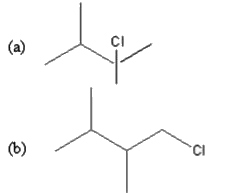The isomer of hexane that gives the minimum and maximum number of monochloro derivatives are respectively
A
3-methylpentane and 2, 3-dimethylbutane
B
2, 3-dimethylbutane and n-hexane
C
2, 2-dimethylbutane and 2-methylpentane
D
2, 3-dimethylbutane and 2-methypentane
Text Solution
The correct Answer is:D
The possible isomers of hexane are:

Out of these structure (iii) and (i) have respectively minimum and maximum number of monochloro derivatives.
For structure(iii)

[Only 2 monochloro derivatives (minimum) are possible]
For structure (i)

[5 monochloro derivatives (maximum) are possible]
|
Topper's Solved these Questions
Similar Questions
Knowledge Check
Of the isomeric hexanes, the isomers that give the minimum and maximum number of monochloro derivatives are respectively.
A2,3-dimethylbutane and n-hexaneB3-methylpentane and 2,3-dimethylbutaneC2,2-dimethylbutane and 2-methylpentaneD2,3-dimethylbutane and 2-methylpentaneOf the isomeric haexanes, the isomers that give the minimum and maximum number of monochloro derivatives are, respectively,
A3-methylpentane and 2,3-dimethylbutaneB2,3- dimethylbutane and n-hexaneC2,2- dimethylbutane and 2-methylpentaneD2,3- dimethylbutane and 2-methylpentaneOf the isomeric haexanes, the isomers that give the minimum and maximum number of monochloro derivatives are, respectively,
A3-methylpentane and 2,3-dimethylbutaneBn-hexane and 2,3-dimethylbutaneC2,3-dimethylbutane and 2-methylpentaneD2,2-dimethylbutane and 2-methylpentane
The isomer of C6H14 which will give maximum number of monochloroderivative is
View SolutionWhat is the number of monochloro substituted derivatives formed from diphenyl methane?
View SolutionOf the isomeric haexanes, the isomers that give the minimum and maximum number of monochloro derivatives are, respectively,
View SolutionThe number of monochloro derivatives of isohexane is
View SolutionThe isomer of C6H14 which will give maximum number of monochloroderivative is
View Solution


